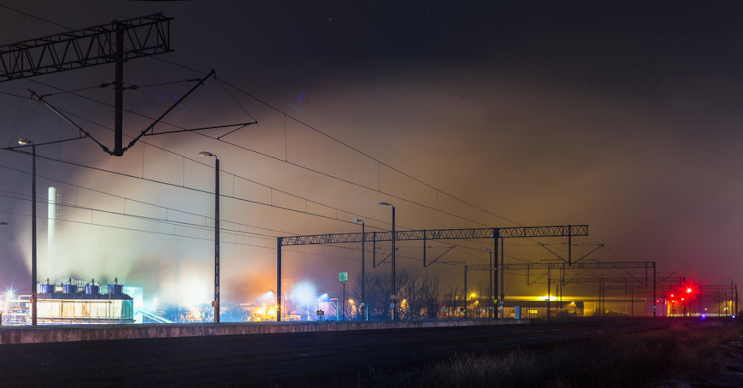Archives
June 2024
Categories
All
|
Back to Blog
The air/light pollution connection5/1/2024 Image credit: Sakuto/Flickr / CC BY-NC 2.0 1602 words / 6-minute read Summary: Air and light pollution are both scourges of modern life in many world cities. In this post we examine how air pollution affects the brightness of the night sky and why light pollution at night may make daytime air quality worse, arguing that sensibly regulating outdoor lighting could help clear the air over cities. When people hear the word "pollution," they may think of many different things. One that comes to mind immediately is air pollution, which is easy to perceive because it is often visible to the eye. The familiar brown cloud over some cities where air pollution is prevalent is its major manifestation. But much of the problem of air pollution is invisible, as it constituents don't interact with light in ways that the human eye can see them. Despite its name, light pollution has some similarities with air pollution in that sense. One of them is that many of its hazards are not immediately obvious to people. Not all its affects are visible to the eye in a direct way. And many people don't notice it at all, given that it is most evident when few people are awake to see it. We often frame light pollution as an environmental problem in that it is a problem of the environment. In other words, it is a way in which human activity interacts with the environment to cause harm. But it is also a problem for the environment, in that it negatively affects the environment in particular ways. We have previously written here about how light pollution relates to climate change. It does so through electricity consumption and carbon emission. But artificial light at night (ALAN) also interacts with the air itself, changing its chemistry. Those changes can reduce air quality and impact public health. In this post, we dissect the two ways in which light pollution and air pollution interact. And we close with an argument for why dealing with one problem can help solve the other (and vice versa). The threat of air pollutionScientists realized many years ago that poor air quality, especially in cities, can lead to adverse health outcomes. In particular, small particles suspended in the air, called aerosols, have harmful effects on human health. Very fine particles known as "PM2.5" are so small that they can travel deep into the human respiratory tract. There they reach the lungs, embedding themselves in tissue and causing both short- and long-term health effects. The dominant source of PM2.5 in cities is exhaust from the internal combustion engines in motor vehicles. But they also come from burning wood, natural gas and other carbon fuels, and fires. We also know that aerosol air pollution has a strong interaction with local weather conditions. When air over cities becomes stagnant and does not move, the pollution can settle in for many days at a time. This is especially true in winter when temperature inversions in the air may occur. Only when the winds change and blow the pollution away does the air quality tend to improve. Efforts to write laws intended to reduce air pollution began in the 1950s. Where governments implemented such policies, they have been spectacularly successful. Despite these outcomes, air quality measures still have many opponents. The main objection they raise has to do with the cost of the regulations. As a result, one-third of the world's countries still have no laws regulating air quality. Over eight million people worldwide die each year from complications due to air pollution exposure. [1] Beyond reducing this public health burden, there are other reasons to reduce air pollution. One of them is that doing so would also reduce light pollution. Air pollution "amplifies" skyglowSkyglow is a phenomenon involving ALAN emitted on the ground. It travels upward into the sky, where it interacts with molecules and aerosols in the atmosphere. These interactions direct some light rays back down toward the ground. Observers looking toward the sky see some of this light. It competes with the light of the stars beyond, making it difficult to see them. This is the familiar experience for anyone who has lived in or visited a city where there are a few stars in the night sky. The same aerosols responsible for air pollution also affect this light. The smaller particles tend to interact with light more strongly than larger particles. The effect is stronger for light that is more blue compared to other colors. This is the same reason why the daytime sky is blue and not some other color. Scientific research has shown that the interaction between ground light and aerosols can make the night sky brighter. In places where air pollution is prevalent, this effect is stronger. [2] The connection between them is solid. Researchers now use nighttime light measurements from space to estimate how much PM2.5 is in the air. [3] In 2021, we hypothesized that reducing air pollution over cities would also reduce night-sky brightness. We expected that the effect would persist even when all other influences on skyglow were fixed. To test this idea, we measured the sky brightness over a city before and after the passage of a weather front. These moving airmasses tend to clear out air pollutants where they collect under usual conditions. The experiment validated our hypothesis. [4] We saw reductions in the brightness of the night sky by up to a factor of 2.5 as the frontal boundary passed. No other explanation best accounts for the measurements than clearing the air of aerosol pollutants. The result also matches observations from other measurement sites where air pollution is significant. From this result we argued that, after improving outdoor lighting, reducing air pollution could be the next-best way to lower skyglow. ALAN may increase air pollutionThat would be the end of the story if we were only concerned about skyglow. But there is another way in which air and light pollution are intimately related. If on the one hand we talk about tackling light pollution by clearing the air, on the other it may be that reducing light pollution can itself clear the air. Some air pollution results from the direct action of burning fuels. For example, sometimes motor vehicles will emit visibly dark clouds from their tailpipes. Many people have in mind that this kind of scene is what air quality laws have in mind to prevent. But some materials emitted by vehicles and through other activities do not immediately become "pollution". Rather, they dwell in the atmosphere for hours to years. Some of these chemicals react with sunlight or other compounds in the atmosphere to form visible hazes. Natural processes in the air can "clean" certain pollutants by reacting with them chemically. One of those is the nitrate radical (NO3). Nitrate reacts with volatile organic materials that would otherwise become ozone molecules and smog. But it only works at night because ultraviolet light from the Sun in the daytime destroys it. In 2010, Harald Stark and his collaborators wondered whether ALAN could play a similar role. They set up a clever experiment to find out. In Stark's experiment, the researchers outfitted a small airplane with sensors capable of detecting both nitrate radicals and ozone, as well as ALAN. They flew the plane over Los Angeles, California, at night. Then they flew the plane over the Pacific Ocean and compared the measurements with those from the city. The nitrate concentrations showed distinctly different patterns over the city versus the ocean. From this the team concluded that city lights were interfering with the nitrate radical's nighttime work. [5] Although the effect was small — only 4% — the reliability of the measurements was high. Since then, other research has pointed toward ALAN's influence on harmful ozone [6] and nitrogen dioxide [7] levels. It's important to note the limitations of these studies. They have so far been carried out on relatively small scales, and they find small effects. But as city lights get brighter around the world, the significance of the issue is expected to grow. So it makes sense to consider which solutions are most effective. Reducing both air and light pollution is good policyIn 2021 we wrote that "cleaner air not only has obvious public health benefits, but it could further reduce diffuse artificial light in the night sky and improve astronomical viewing after the utility of other methods such as lighting changes has been exhausted." [4] Connecting the two in this way might be a means for dealing with both issues at once. Although cleaner air is the goal that resonates most with the public, "clean" night skies have some appeal. Dealing with the main sources of air pollution is difficult, but we may find it easier to score some wins around the edges of the challenge. The best policy approaches for reducing ALAN's influence on air pollution have to do with timing. Much of the chemical mechanism involved in scrubbing pollutants from the air works during the overnight hours. Limiting the times in which outdoor lighting is used through curfews is an important tool. Another is insisting on full shielding of all lighting. This ensures that the direct emission of light into the night sky is limited or eliminated. The third leg of the stool is limiting total light emissions. Given that much of the light pollution we see in the world results from over-lighting relative to needs, we expect these methods to work well. Light pollution is perhaps the only environmental problem of our time that is fully reversible. What's more, we know that the solutions are cost-effective and produce the anticipated results when implemented correctly and consistently. Solving the problem might also have the added benefit of tackling air pollution in and near urban areas. This not only adds to the quality of life in cities, but it does so without any obvious downsides. It's an easy win that the world desperately needs. References
0 Comments
Read More
|
 RSS Feed
RSS Feed

